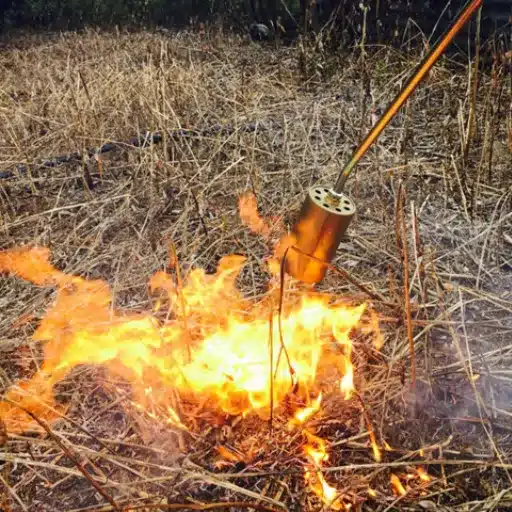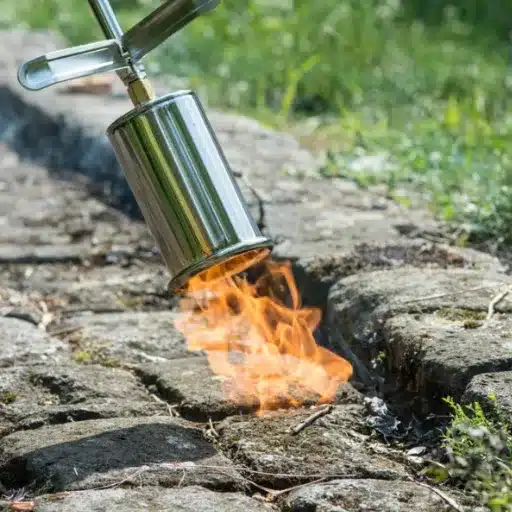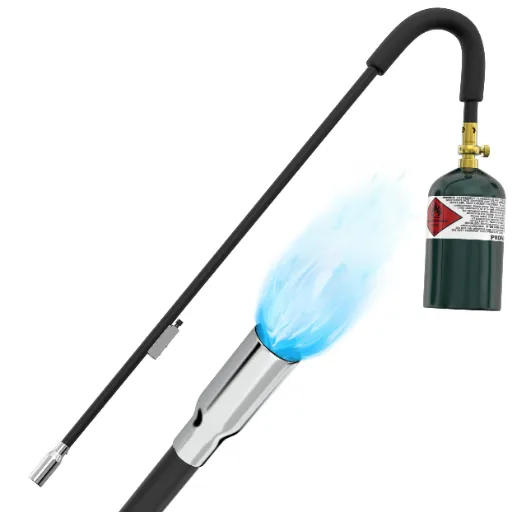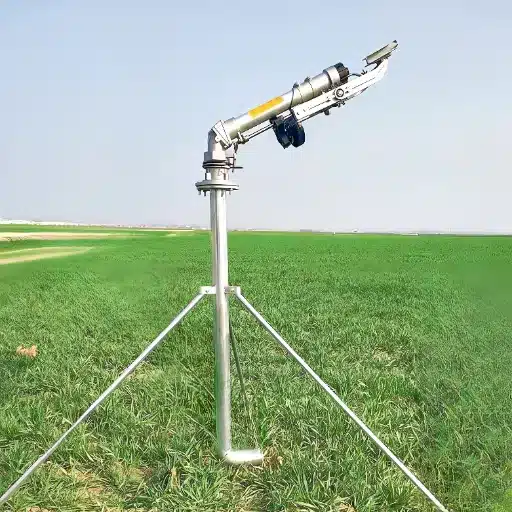One can frequently feel challenged when it comes to maintaining a pristine backyard, void of any unnecessary materials, especially during harsh weather conditions or in autumn. Although typical rakes and leaf blowers are handy, they often leave you feeling frustrated due to the time invested and the physical labor required. This is where a lawn sweeper steps in, and you do not need to be a gardener to know that this is a marvelous invention. However, what is a sweeper and how can it help you? In this write-up, we take an in-depth look at how lawn sweepers work, their pros, and why a lawn sweeper might be just what you need to obtain that enviable, beautiful lawn without much effort. Whether such a person has sufficient experience working in their own garden or will need to try some additional methods to clean the lawn, this article will provide them with all the necessary information, guidance, ideas, and encouragement to enable them to use lawn sweepers effectively in lawn care quickly.
Brief Introduction to Lawn Sweepers
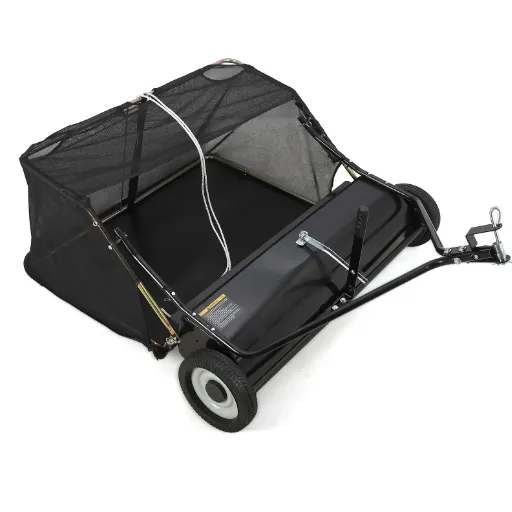
Lawn sweepers are devices that homeowners and garden owners use to keep their yards clean and debris-free without any hassle. They use an operational principle where rotating brushes collect or attract leaves, grass trimmings, pine needles, and other garden debris into an included container for collection. This is a fantastic feature of lawn sweepers, as they work in a much lesser time than backbreaking raking and also reduce the yard cleaning effort. They come in two models: the rolling ones for those with lawn tractors and the pushing models for smaller lawns. A sweeper provides an easy solution to the problems that owners of grounds face in keeping the lawns neat, particularly at the end of summer or after mowing work.
Definition of a Lawn Sweeper
A Lawn sweeper is a specialized garden tool created to ease the process of maintaining a yard so that there is no rubbish, including leaves, grass, pine needles, and remnants of small branches and twigs, left on the lawn’s surface or driveways’ surfaces. A lawn sweeper consists of rotary brushes that sweep debris into a receptacle, from which the rubbish can be disposed of. Depending on your preference and budget, you have two broad classes of lawn sweepers—those for pulling behind a garden tractor or a ride-on lawn mower, and the sweeping manual mowers to cater to the needs of smaller areas. Many of these implements even have adjustable brushes that enable the user to use the sweeper effectively. This large bin capacity prolongs use without requiring a second emptying, and is impressively lightweight because they are carried when in use. These are an attractive and cost-effective alternative when cleaning the yard of fallen leaves. Using rakes is no longer exciting, especially during the busiest months like autumn, which helps to avoid physical strain.
How a Lawn Sweeper Works
Sweepers are powered up by rotating brushes to get leaves, grass, and other dirt off the ground and store it in a container. Depending on their mobility, sweeping brushes can sometimes be moved with the help of the forward movement of the sweeper or be attached to a tractor. The height can also be adjusted to sweep other roughness and/or smaller sizes and types of debris, resulting in significantly improved cleaning. In the case of more advanced lawn sweepers on the market, these models contain larger bins, allowing for the coverage of larger areas before needing to empty the bin. Some models also feature comfortable-to-hold handles or areas where you can easily grip the product. Owing to the strong molding equipment and new designs, lawn sweepers make lawn maintenance easier for both house owners and professional gardeners.
Common Uses of a Lawn Sweeper
Clearing Leaves
Lawn sweepers are highly efficient and multiply the job of heap-detail collection during the autumn. In a more practical sense, they sweep leaves much faster than the conventional raking method, saving time. The high-capacity lawn sweepers are capable of acquiring more than 20 cubic feet of leaves in one haul, hence enabling us to dispose of the grass only once.
Removing Grass Clippings
Let’s do the last lawn cutting, sweeping the grass trimmed in the yard with a sweeper. This is very important as it preserves the image of clean-cut, healthy grass in early seed high-test lawn construction, and it prevents the buildup of matted grass clippings from affecting the growth of the grass beneath it.
Cleaning Up Twigs and Sticks
All kinds of sticks and tiny woods can be produced after a storm or heavy wind. High-end lawn equipment designs for paving and cleaning are available that help customers with household needs, especially those requiring brushes that can be used on various types of ground.
Clearing Pine Needles and Cones
Unraveling pine needles and cones from their comfortable position is a herculean task for two related reasons. One is due to their stiffness, while the other is highly generated in the lawn. Advanced lawn sweepers are typically adjusted to the coverage of brush particles, such that it is an elementary job to clear out leaves and pine straw.
Picking Up Acorns and Nuts
For properties containing deciduous or fruit trees, lawn sweepers are a lot more helpful. They tend to mitigate the impact of extensive collections of acorns and other debris, which would otherwise be difficult to clean up.
Maintaining Driveways and Patios
Using motorized sweeper vacs without a self-propelled mechanism does not limit them solely to lawn cleaning, as they are suitable for use on various surfaces, including motorways, patios, and walkways, in both urban and rural locations. These can also assist in cleaning up loose matter, such as soil, stones, and other particles, within a plot of land, thereby incorporating other useful landscaping elements that make the landscape look more attractive.
Functionality of Lawn Sweepers
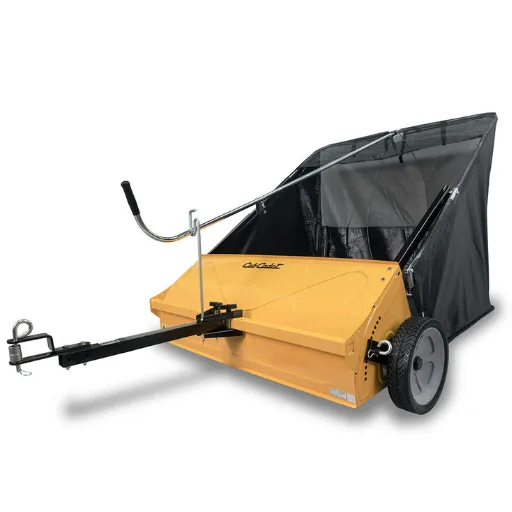
Lawn sweepers are vacuum machines equipped with a motorized roller brush that lifts debris it comes into contact with and conveys it to a special suction wastebasket. The machines are designed to effectively clean dried leaves, grass, sticks, and other debris from lawns, as well as from surfaces such as roads. As for this equipment, some of it is propelled while others are pulled behind a tractor, depending on the terrain. Changing the angles of the brush will help you utilize the implement on rough roads, while the rubbish container is easily removable. Rakes are one of the oldest tools for keeping leaves at bay, but lawn sweepers can accomplish this task more efficiently, maintaining a clean and presentable backyard.
Comparing Sweeper vs Bagger
| Key Point | Lawn Sweeper | Lawn Bagger |
|---|---|---|
| Primary Function | Sweeps and collects debris | Collects grass clippings and debris |
| Debris Collection | Uses rotating brushes | Uses vacuum suction and bags |
| Capacity | Large collection hopper | Smaller bag capacity |
| Suitable Debris Types | Leaves, twigs, grass clippings | Grass clippings, small debris |
| Terrain Compatibility | Works on uneven surfaces | Best on even lawns |
| Attachment Method | Can be towed or pushed manually | Attached directly to mower |
| Ease of Use | Requires minimal effort | Depends on mower compatibility |
| Cleaning Speed | Covers large areas quickly | Slower for extensive areas |
| Maintenance Needs | Low maintenance, occasional cleaning | Bags need regular emptying |
| Cost | Generally affordable | It can be more expensive |
Using a Lawn Sweeper for Effective Yard Work
In the event of taking care of the garden, the lawn sweeper is an excellent method. This equipment also proved highly efficient due to its design, which employs the use of rollers that collect dirt such as dead green leaves left behind by dry sunshine, cutting hay and other such forms of trash among them small pieces of plants and then puts it in the bin where it can be disposed. This is unlike the normal solution, where all the work is attempted on earth, which not only consumes time but also is very hectic and consumes a great deal of physical strength due to its demands.
Moreover, a limitless number of lawn sweepers can be used without any regard to the terrain, with some manufacturers of commercial property attire taking the market steps forward. Most of the time, they are found to be the most useful tools in regions where a lot of unwanted grasses collect, especially in the two seasons, namely fall and spring. Regardless, the use of a lawn sweeper can be of great value to the turf of the user because, given that one of the factors for the negative growth of the grass is the deposition of debris on the surface, sweeping will help to prevent the thatching from occurring since all the debris will be aerated. There are also other benefits to using such a mower, like the launch of great efforts to raise ecological awareness in such people, because the best lawn sweepers require no fuel, no electricity, only mechanical or manual or towing methods are applicable.
One potential rationale for introducing a lawn sweeper to your lawn care routine is that it can help you maintain a garden that looks new, healthier, and more beautiful with minimal effort.
Main Types of Lawn Sweepers
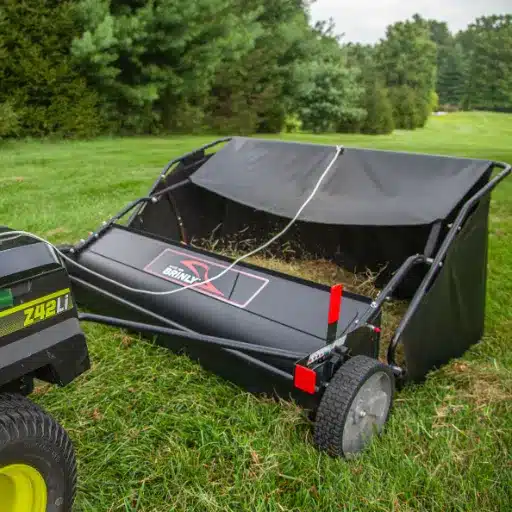
There are three main types of lawn sweepers to choose from:
Push Lawn Sweepers
These are the real force sweepers. They are manually-powered and high-capacitated ones. It can be used on small yards. They are light, easy to manage, and able to trap thin leaves and grass clippings effectively.
Push lawn sweepers were built on the concept of providing the best option for those who would prefer mowing their lawns in a lightweight and easy way. These sweepers are operated manually and are a favourite among many, as they dispose of waste without harming the environment or others. Whether at home or at the park, if one has a small to medium-sized grass yard, a push lawn sweeper is capable of picking up leaves, chunks of lawn, and any other material up to a certain weight with less effort. It is noteworthy that modern push sweepers are equipped with varying height settings, allowing users to adjust them for all types of surfaces, including grass and tarmac, with great precision. Their small size, combined with effective folding, makes them a great asset for domestic users seeking an easier and more affordable means of garden maintenance.
Tow-Behind Lawn Sweepers
They are for field sweepers, on the other hand. These are larger and are made to be attached to the rear of a lawn tractor or riding mower. They are very good for heavy debris removal over extended distances with little exertion.
Ride-on lawn mowers, generally speaking, are used on larger properties and by professionals, which is very convenient for quickly removing litter. These lawn sweepers are connected to a tractor or lawn mower, allowing users to cover a large area efficiently. A bulk absorbs 38 to 52 inches of the area where there is a need for sweeping, these perfect-length towels that are made for leaves, grasses, pines, smaller branches, and so on. There is a demand for these attachments with slight modifications aimed at increasing the heights of the grounded brushes so as to ease the collection of materials without causing damage to the machines. Primarily, the pull-behind sweeps come in handy when there is residential cleaning to be done after every individual monthly activity or excessive debris in larger landscapes. When many are in place, the pull-behind units become the most articulate option for anyone taking care of home or business premises.
Powered Lawn Sweepers
To enhance cleaning performance during heavy-duty tasks, these are powered push sweepers and are also suitable for medium to large-sized lawns. From branches to pine cones, they can handle large volumes of dense leaves easily.
A powerful lawn sweeper is an excellent device for individuals who want to remove debris from medium to large property areas efficiently. This device generally works by using mechanized brushes, along with other means, to remove or pick up waste such as fallen leaves, cut grass, or even pine cones, requiring less manpower. Various powered sweepers are also suitable for use in low-brush settings, and brush heights can be set for specific areas or work. And some upgraded versions of these – those that have larger dust bins that can be used for longer durations, might even have easier handles designed to make controlling the machines easy, and some have mulching systems too. Attached to the sweeper are some gadgets, including a waste receiver, which makes the sweeper particularly useful in such a place. For individuals with their own homes, landscapers, or those involved in maintaining golf courses, powered cleaning devices significantly reduce the time required for cleaning while also adding neatness to every area.
Note: The best lawn sweeper for your specific yard is influenced by the lawn sweeper size, landscape type, whether you would like a push or motorized lawn sweeper, among other factors.
Benefits of Using a Lawn Sweeper
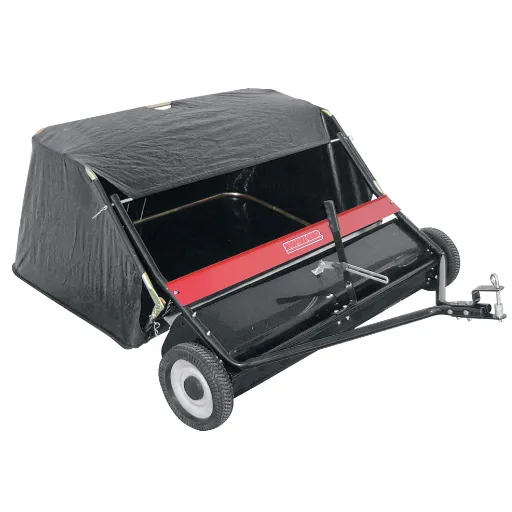
Time Efficiency
Routinely, the best way to remove leaves, grass clippings, and other debris found in a yard is through the use of a lawn sweeper, which is much more efficient than the laborious and slow-paced traditional methods, such as raking.
Ease of Use
Lawn sweepers are also very easy to use at all conventional levels, without requiring much effort, thus minimizing the likelihood of the user developing fatigue-related stress.
Improved Lawn Appearance
The lawn sweeper also helps maintain the lawn’s beauty, thereby keeping the property in its best condition.
Waste Reduction Options
Whereas particulate matter on the collection lawn remains a principal objective, dumping of these waste materials onto garbage dumps is avoided and eliminated as much as possible, which is one large advantage of the use of mulching in this periodical lawn care maintenance.
Versatility
When it comes to clearing up fallen debris, lawn sweepers have several features that can handle a wide range of debris, including leaves, pine needles, twigs, and even garbage, making them a very handy implement for year-round use.
Advantages for Different Users
Benefits for Homeowners
Time-Saving
Using a lawn sweeper not only helps reduce operational costs but also speeds the process of yard clean-up compared to manual efforts. For example, some surveys have cited that the use of a lawn sweeper can be 50% faster than manual methods of debris removal, thus enabling homeowners to engage in other activities fully.
Improved Lawn Health
Another term is lawn sweeper, which accomplishes the same task as the rake. A rigid broom designed to push grass clippings and leaves to the inside of the machine, it is very beneficial as the owner washes the machine and keeps it in a cool, dry place.
Cost Efficiency
The benefits of using a lawn sweeper in the garden outweigh the additional cost for a home gardener. The significant savings accrued by the homeowner in terms of employing professional garden maintenance personnel and purchasing laminated paper yard bags to fit all the compost are also the advantages that come with this lawn cleaning machine. There are also grinding functions that inject cutting matter and waste into the lessening need for commercial compost.
Reduced Physical Strain
Sweeping the floor is well within almost everybody’s capabilities; it demands less engagement than any other form of yard work, such as raking and other aspects of manual labor, even when done on easy mode. Some people cannot afford the active way of cleaning their lawns due to back illnesses and other disorders; it is more comfortable and easier for them to do their work by using the equipment they have purchased.
Environmental Benefits
Despite all this, the existing lawn sweepers are very human. Transportation is provided, and the requirement for transfer is eliminated; you simply push. Mulching serves a highly functional purpose, as it allows the user to utilize the lawn nuisance and turn it into natural fertilizer, breaking environmental barriers of standard gardening practices.
Year-Round Usability
Lawn sweepers remain a necessary equipment throughout the year, be it removing leaves in autumn, errant pine needles during winter snow removal, or mowing grass in summer. There is an assurance of a consistently well-kept yard in all seasons, regardless of the time of year.
Benefits for Landscapers
Time Efficiency
Lawn sweepers aid landscapers in finishing up the yards quickly than if they were to rake or use the usual tools. For example, it is possible to clean a standard yard in half the time it would take while raking, allowing more clients to be serviced in a day by the landscapers.
Cost-Effectiveness
As a result, such activities, such as moving plants, attempting to eliminate all the leaves, and other similar tasks, will enable a business to reduce the amount of labor and lower its costs. Furthermore, nowadays, modern machines used for lawn cleaning are of high quality and durable, which helps offset these expenses in the long term.
Enhanced Yard Aesthetics
That experience almost guarantees that the property will look clean even after the cleaners have left, within the context of providing high-quality services by landscapers and client satisfaction, which will lead to recurring business for this company.
Reduction in Physical Strain
Raking up and collecting leaves or clearing out a particular area can be quite energy draining. Too often, the most effective and efficient solutions that can be used to some extent without explanations are rarely utilized. Lawn sweepers significantly reduce the amount of physical input, allowing landscapers to focus on larger tasks without straining themselves throughout the day.
Seasonal Flexibility
A lawn sweeper is essential equipment for every landscaper, whether to dispose of leaves in the fall, pick up pine needles in the winter, or clean off grass clippings in the summer. It can be used all year round to clean the garden dirt, allowing for timely work. Such a quality gives advantages for bringing out more work in a given season.
Eco-Friendly Practices
Within this framework, various yard waste management mechanisms, such as composting, are often offered to landscape customers. This is consistent with the increasing number of such requests across the landscape properties.
Enhancing Lawn Health
A well-maintained lawn is not only visually appealing but also benefits the environment as a whole. Applying tools such as lawn sweepers regularly to remove debris also helps prevent the accumulation of thatch in the lawn. In particular, thatch promotes the growth of the soil, which in turn causes the soil to become saturated with water, reducing the absorption of any nutrients from the soil. Also, keeping lawn waste to a minimum helps eliminate the risks of diseases and problems occurring in the lawn. Core aeration, partial mowing, and periodic fertilization are basic measures that enable lawns to develop stronger roots and healthier grasses. It is shown that for a beautiful, evergreen lawn, the pH of the soil should be kept in check always, as well as the irrigation, with special regard to the type of grass grown, so as to maintain it well during all the seasons.
Effective Usage and Maintenance Tips
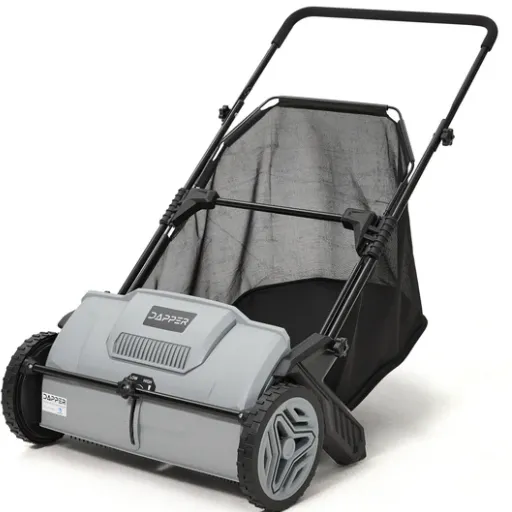
- Mowing – Adjust the length of your grass according to the recommended setting for the type of grass in your lawn. Refrain from cutting off more than an inch of the top growth so as not to weaken the lawn.
- Watering – Water the plants more deeply and less often so as to encourage a deeper and healthier root system. It is, in fact, the best time to water the plant early in the morning because it is a general practice, as it minimizes the risk of evaporation losses and of fungi.
- Fertilizing – Apply fertilizer seasonally based on your lawn’s needs, ensuring it provides the right balance of nutrients. Use slow-release fertilizers to avoid overfeeding.
- Aeration – When the soil is loosened, it becomes more permeable to air and water if done once a year. Doubling the number of times the period is done accordingly enhances the chances of air and water circulation in the soil, also.
Remember that consistent application of the strategies above will help you maintain a beautiful lawn that thrives throughout the year with minimal setbacks and very low resource pressure.
How to Use a Lawn Sweeper Properly
Utilizing lawn sweepers can significantly reduce the amount of work required to maintain the lawn’s cleanliness and good appearance. Use the following methods to get the best out of a lawn sweeper:
- Select the Appropriate Sweeper Type – A lawn sweeper comes in two ways: push and pull, which is pulled with any other tractor attachment of the same size. You should not sweep a lawn too big with a push sweeper, which does not need to be connected to a lawn tractor.
- Adjust the Height Setting – Put the brush away with a lower tender so that it affects the grass very slightly. If it is kept low, damage can and will be inflicted on the lawn or the soil might be picked up, while keeping it high will not collect the dirt.
- Prepare Your Lawn – Make your work in cleaning the street easier by first removing large branches or debris, such as stones, that are already there. Then cut the grass to a certain level that will make the collection of debris easier.
- Sweep Efficiently – Ensure the lawn sweeper is being walked or driven at a steady speed, typically between 2 and 3 mph, to prevent it from running too quickly and missing some debris. It is also recommended to provide an overlap on sweeping paths of the sweeper to guarantee the complete elimination of dirt.
- Empty the Hopper Frequently – Preventing the efficiency of the sweeper from degrading requires constant removal of materials from the bag or hopper, especially when there are loads of leaves, twigs, or grass.
- Perform Regular Maintenance – One should regularly inspect the brushes and the hopper to ensure they are in good working condition. Clean up the sweeper after use, and store it in a dry and covered position, which reduces the frequency of repairs.
The correct use of the lawn sweeper will help save time and effort, allowing you to clean up your beautiful front yard with ease.
Maintenance for Longevity
For your lawn sweeper to remain durable, regular modifications and servicing are necessary. Start by examining the moving parts of the lawn sweeper, specifically the brushes and wheels, for any signs of wear, tear, excessive use, or damage. If worn-out brushes are noticed, they should be changed immediately, as they will directly impact the efficiency of the sweeper. The wheels, as well as other mechanical parts, should also be lubricated periodically to reduce friction and prevent rust. Fieldwork should be carried out in a manner that allows self-tapping screws that have become loose or nuts that have loosened to be retightened, ensuring the support is not disturbed.
Always keep the sweeper in a neat, dry environment that is protected from harsh climatic conditions. Even in the absence of these harsh weather conditions, shelter is provided from ice and snow, etc. If this is possible, the equipment should always be safe from dust and moisture with a protective film. Finally, one of the most important things to do after using the lawn sweeper is to clean it. Ensure that the brush roller, the hopper, and the hopper attachment, as well as the frame, are all free from debris and dirt, which can ultimately cause blockage and deterioration. The practice of these maintenance activities permits the lawn sweepers in operation to not only function more efficiently but also more profitably and reliably while remaining fully operational throughout time.
Reference Sources
- Summary: This study focuses on designing a small lawn garbage sweeper to address the challenges of cleaning leaves and debris from lawns. The sweeper uses a motor-driven cleaning roller and a traveling mechanism to automate the cleaning and recycling process. The design emphasizes efficiency and ease of use for small-scale lawn maintenance.
Frequently Asked Questions (FAQs)
Q: What Does a Lawn Sweeper Do?
A: A field vacuum sweeper is equipment specifically designed to clear lawn surfaces that might be littered by different types of waste material, such as leaves, grass, and any other refuse in the yard. It works by rotating brushes to pile the waste and push it into a hopper or container attached to the system. This equipment significantly improves the cleanliness while also making it easier to clean up after yourself when working in the yard. There is no need to spend time and effort raking or blowing the leaves when you have a sweeper, as it collects all the debris in one step. If you are looking for ways to maintain a beautiful lawn, whether you have a small garden or a large yard, a sweeper can be helpful. It is most beneficial during autumn, when leaves get scattered all over the place.
Q: How Does a Lawn Sweeper Work?
A: By using rotating brushes, a lawn sweeper is made to brush across the lawn and sweep leaves and clippings into a collecting bag or hopper. When in motion, the brushes of these sweepers begin to move, and the dirt that accumulates is stored in the basket until it is full. The discharge, or dumping of the hopper’s contents, can be promptly done when the charges inside the bag have reached maximum. This nifty piece of equipment greatly assists in vast areas of lawns or scattered leaves, as it reduces the strain of human power. The lawn sweeper will also aid in keeping your garden neat and tidy along traditional systems like raking without the spoils of its productivity.
Q: What Are the Benefits of a Lawn Sweeper?
A: There are many reasons to have a lawn sweeper, which will make your garden-keeping activities much better. To begin, it speeds up one’s work since you are able to pick up more litter without making too many stops. This is possible as some of the lawn sweepers have an extra-wide loading bin. Another advantage of operating a lawn sweeper is that it helps protect the mower blades, as it seeks to pick up any potentially harmful material before mowing. Proper care of the yard will in turn result in marshy soil albeit a reduced ability to grow more grass. Moreover, debris that is removed during unlucky mowings can be stored and used for compost later. Thus, on the whole, in most cases, the cost and fun of an outside space improvement project arises with the purchase of the lawn sweeper.
Q: What Types of Lawn Sweepers Are Available?
A: Lawn Sweepers of different designs can be found based on the size and scope of the land. The commonest garden pickers are the sizes on wheels, tow-behind ones, which can be attached to a small tractor or a garden tractor. Others, which are much simpler, include garden yard sweepers on wheels that can be pushed manually. If you feel the one that snaps on is not enough, there are even more thoroughly designed lawn sweepers with a leaf bagger option. If you want to break a sweat and do not like mechanical issues, the push lawn sweeper is just fine. Every type of lawn sweeper improves performance; thus, it is a must to order or purchase a lawn sweeper that matches the yard size and the size of debris that usually needs to be removed to avoid disappointment.



